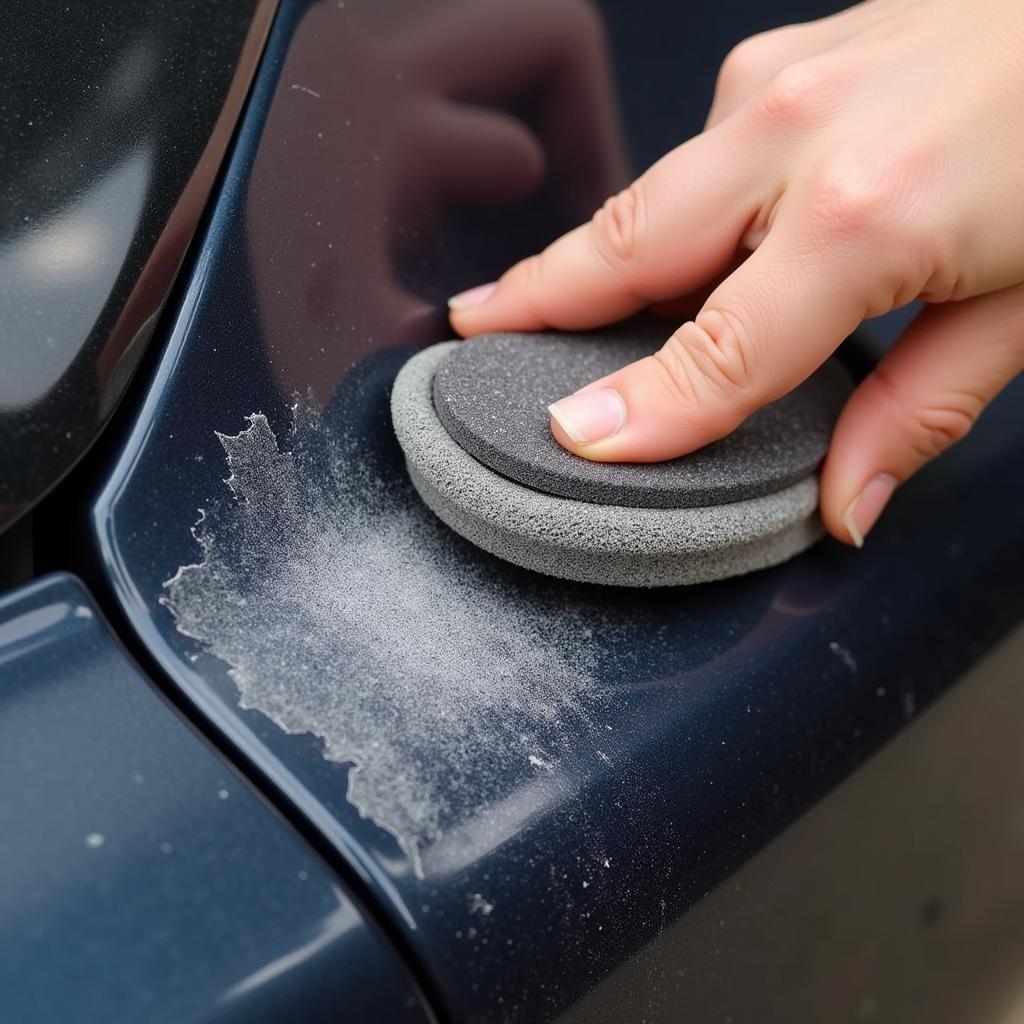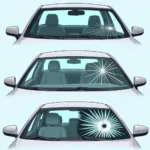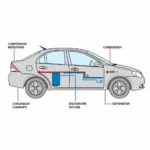A scratched bumper can be a real eyesore, detracting from the overall appearance of your car. Fortunately, repairing scratches on a plastic car bumper is often a manageable DIY job. Whether you’ve scuffed against a wall, had a minor parking lot mishap, or noticed unsightly scratches from everyday wear and tear, you can restore your bumper to its former glory with the right tools and techniques. This article will guide you through the process of assessing the damage, choosing the right repair method, and achieving professional-looking results.
Assessing the Damage: Is it a DIY Job?
Before diving into the repair process, it’s crucial to assess the severity of the scratches on your plastic car bumper. Some scratches are superficial and can be easily buffed out, while others might require more extensive repair work.
Here’s a quick guide:
- Clear-coat scratches: These are the easiest to fix, often buffed out with a polishing compound. They appear white and don’t expose the plastic beneath.
- Shallow scratches: These have penetrated the paint but not the plastic. You can typically address these with touch-up paint and clear coat.
- Deep scratches: These expose the plastic underneath and might require filling, sanding, priming, and repainting.
For very deep scratches, cracks, or damage that extends beyond the bumper itself, it’s best to consult a professional auto body shop. They have the expertise and equipment to handle more complex repairs.
DIY Repair Methods for Scratched Plastic Bumpers
For those scratches you can tackle yourself, here’s a breakdown of common DIY repair methods:
1. Buffing Out Minor Scratches and Scuffs
For minor clear-coat scratches, using a polishing compound is often enough:
- Clean the area: Thoroughly wash and dry the scratched area of the bumper.
- Apply polishing compound: Apply a small amount of rubbing or polishing compound to a clean microfiber cloth.
- Buff the scratch: Gently rub the compound onto the scratch using circular motions.
- Wipe away excess: Once the scratch fades, wipe away any remaining compound with a clean microfiber cloth.
2. Repairing Shallow Scratches with Touch-Up Paint
For scratches that have gone through the paint layer, you’ll need touch-up paint:
- Clean and prep: Clean the scratched area with soap and water, then dry it completely.
- Apply touch-up paint: Carefully apply thin coats of touch-up paint that matches your car’s color. Use a fine-tipped brush or a toothpick for precision.
- Allow to dry: Let each coat dry completely before applying the next.
- Apply clear coat: Once the touch-up paint is dry, apply a clear coat to protect the area and blend it with the surrounding paint.
how to repair a scratched plastic car bumper
3. Fixing Deep Scratches with Plastic Filler
Deep scratches require a bit more work:
- Clean and sand: Clean the area thoroughly. Use sandpaper (around 220-grit) to smooth out the scratch and create a better surface for the filler to adhere to.
- Apply plastic filler: Following the instructions on your chosen plastic filler product, carefully apply the filler to the scratch.
- Sand and shape: Once the filler dries, sand the area smooth using progressively finer sandpaper grits.
- Prime the area: Apply a primer specifically designed for plastics to create a good base for the paint.
- Paint and clear coat: Once the primer dries, apply several thin coats of matching touch-up paint, allowing each coat to dry thoroughly. Finish with a clear coat for protection and shine.
car plastic bumper trim paint repair kit
Tips for a Professional-Looking Finish
“When it comes to DIY car repairs, attention to detail is key,” says John Smith, a seasoned auto body specialist at ABC Auto Repair. “Taking your time, using the right products, and following instructions carefully will yield the best results.”
Here are some additional tips to achieve professional-looking results:
- Work in a well-ventilated area: Paint fumes can be harmful, so always work outdoors or in a well-ventilated space.
- Use painter’s tape: Mask off surrounding areas with painter’s tape to avoid getting paint on unwanted surfaces.
- Apply thin coats: Multiple thin coats are always better than one thick coat, as they dry more evenly and prevent runs or drips.
- Be patient: Allow ample drying time between each step. Rushing the process can compromise the final look.
Conclusion
Repairing scratches on your plastic car bumper doesn’t have to be a daunting task. By understanding the extent of the damage and employing the appropriate repair method, you can restore your bumper’s appearance and enhance your car’s overall aesthetics. While minor scratches can be addressed with simple buffing or touch-up paint, deeper scratches require more involved techniques like using plastic filler and repainting. Regardless of the method you choose, following instructions carefully, working patiently, and paying attention to detail will help you achieve professional-looking results.
If you’re uncertain about tackling the repair yourself or if the damage is extensive, don’t hesitate to seek help from a professional.
repair scratches on car bumper
FAQ
Can I use regular sandpaper on a car bumper?
It’s best to use sandpaper specifically designed for plastics, as it’s less abrasive and won’t unnecessarily roughen the surface.
How long does it take for touch-up paint to dry?
Drying times vary depending on the type of paint and environmental conditions. It’s best to refer to the instructions on your specific paint product.
Can I wash my car after repairing a scratched bumper?
It’s advisable to wait at least 24-48 hours after the final clear coat application before washing your car to allow the paint to fully cure.
What if the scratch is on a textured plastic bumper?
Repairing scratches on textured bumpers can be more challenging. You might need to use a texturizing spray after painting to replicate the original texture.
Is it cheaper to repair a scratched bumper myself or go to a professional?
DIY repairs are generally cheaper, but if you’re not confident in your skills, it’s best to consult a professional to avoid potential mistakes and extra costs.
how to repair scratches on bumper of car
Don’t hesitate to reach out to our expert team if you need further assistance. We’re available 24/7 via WhatsApp at +1(641)206-8880 or email at [email protected].



